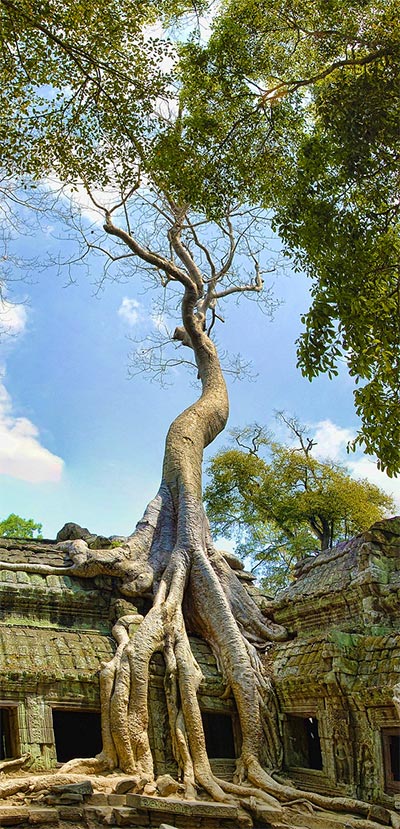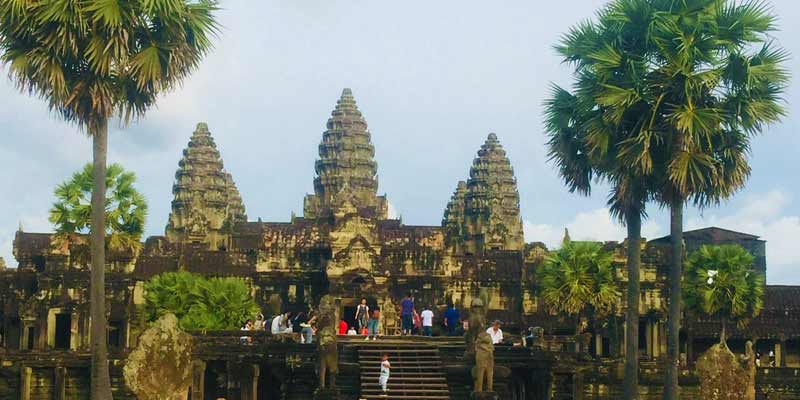The enigmatic temple of Ta Prohm nestles within the sprawling embrace of Cambodia’s Angkor Archaeological Park. The site, renowned for its ancient stone structures’ intertwining with towering trees, invites visitors to reflect on an age-old question: precisely how old are these trees that have forever linked themselves to the temple’s mystical allure?
This article initiates a temporal voyage aimed at deciphering secrets held by Ta Prohm’s timeless giants gracing its grounds.
The Symbiotic Dance of Nature and Architecture
In the late 12th century, King Jayavarman VII constructed Ta Prohm as a dedication to his mother and used it as a Buddhist monastery. Yet, over centuries; colossal silk-cotton and strangler fig trees – embodiments of nature’s relentless force – wove their roots around its ancient stones like an enchanting tapestry.
The symbiotic dance between architecture and nature has birthed an ethereal landscape: all who traverse through its labyrinthine corridors find themselves spellbound by this majestic creation.
Estimating the Age of the Trees
Determining the precise age of Ta Prohm’s trees presents a challenge, it necessitates intertwining scientific methods with historical inference.
The majority—tenacious representatives from species such as Ficus elastica, commonly known as rubber trees; and Tetrameles nudiflora, renowned for their remarkable longevity – populate this ancient site.
1. Rubber Trees (Ficus elastica)
Their massive, spreading roots distinguish these trees; they can envelop entire structures. Typically, rubber trees boast a lifespan of 100-150 years: however, at Ta Prohm –– owing to the site’s unique conditions –– some may surpass this range in age.
2. Tetrameles nudiflora
The Angkor region predominantly hosts this species, distinguished by its unique umbrella-shaped canopy. Estimates propose a lifespan for Tetrameles nudiflora trees of several hundred years; this augments the enigma surrounding Ta Prohm’s arboreal residents.
Historical Context and Conservation Efforts
Undeniably, the trees at Ta Prohm have borne witness to centuries of human history; however, we elude their exact age. The roots interplay with ancient stone structures—this has morphed into a symbol: one emblematic of time’s inexorable passage and nature’s resilience.
At Ta Prohm, conservation efforts strive for a delicate balance: preserving the temple’s atmospheric charm and ensuring both–the structural integrity of stones and trees.
To safeguard the site, where future generations will stand in awe–techniques like tree root consolidation; and monument stabilization are employed with precision.
A Living Testament to Time
While visitors wander through Ta Prohm’s shadowy corridors and sunlit courtyards, the trees stand–silent witnesses to civilizations’ ebb and flow. They embody life’s cyclical nature; they epitomize Angkor’s enduring legacy: a living testament.
The trees’ exact age may shroud them in mystery, yet their presence—unquestionably—contributes an ethereal dimension: it further enhances Ta Prohm’s already enchanting ambiance.
Conclusion
With their sprawling roots and majestic canopies, the trees at Ta Prohm stand sentinel over this ancient temple: they are not just botanical wonders; indeed, they serve as guardians of time, a living testament to the stories etched into its stones.
Exploring these hallowed grounds reminds us that this sacred site’s beauty transcends mere historical architecture—it embodies a symbiotic relationship between ephemeral transience and eternal endurance.





